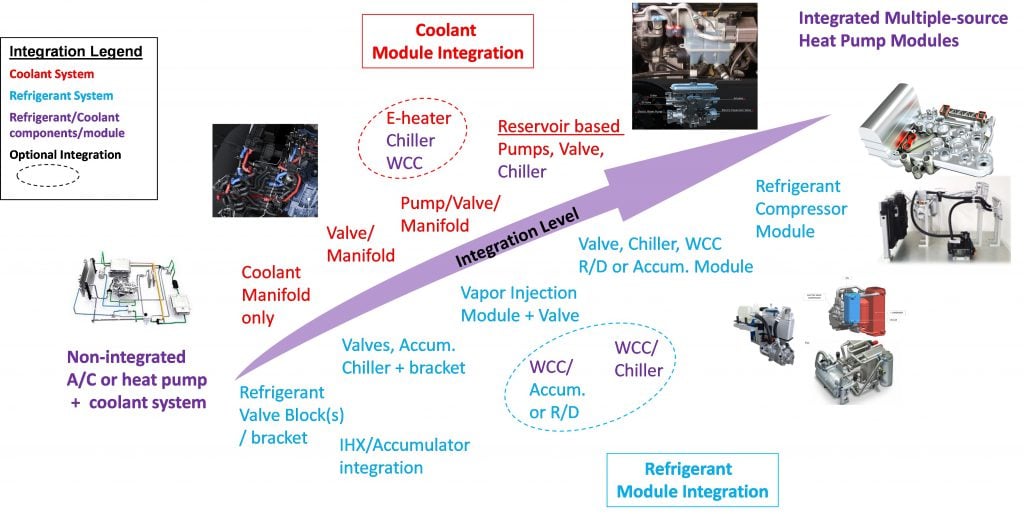BEV Thermal System Integration Challenges
Battery Electric Vehicles (BEVs) have higher thermal system content than conventional vehicles; engine and transmission thermal systems are eliminated but thermal systems for the electric drive system, battery, cabin conditioning, and waste heat recovery are introduced. The thermal system for a BEV may exceed $1400 of content.
Drive and thermal systems are being integrated to improve packaging space and reduce BEV system costs and mass. For example, in BYD’s 8-in-one drive module for its BEV platform 3.0, the thermal system, refrigerant compressor, and fluid control components are integrated with the drive system.
The trend toward thermal fluid system integration is clear, but the exact path is not. The diagram below describes a continuum of integration from non-integrated components in the lower-left toward an integrated heat pump module on the upper right. There are two sides to the continuum, coolant integration shown in red above the arrow, and refrigerant system integration shown in blue below the arrow.
Simplified Thermal Fluid System Integration Continuum

Source: The ITB Group
A wide range of thermal fluid system integration alternatives
Tesla has set the bar for thermal system integration with their heat pump module design. In comparison to other multiple-source heat pump systems, the compact design provides significant cost savings with nested refrigerant, coolant manifolds, and direct-mount pumps and valves. Furthermore, an integrated design allows more space for the trunk by reducing mass, tube/hose, and fluid connections. Tesla’s hardware configuration is complemented by a unique thermal system logic that allows the elimination of dedicated electric heater(s).
However, Tesla’s design is not the only solution; ITB’s research shows that companies are making different choices about fluid integration depending on constraints such as reservoir packaging. Chinese companies may copy Tesla’s manifold approaches. Some companies, like Hyundai, are choosing a “superbottle” approach (with coolant components and a chiller) for their new dedicated BEV platform. Other companies may take more incremental, coolant-focused approaches ranging from bracket-based component integration and coolant manifolds, to pump and valve integration. Another approach might center integration efforts on refrigerant components such as compressor and heat exchanger modules with low refrigerant fluid charge.
The choices companies are making are often dependent on the range of BEV thermal architectures, as integration becomes more important when waste heat and/or heat pump architectures become standardized. A significant share of vehicle thermal systems are expected to have low content and cost in 2031. In tandem, new solutions must be developed and standardized by OEMs and suppliers to reduce costs for high-performance systems. Furthermore, internal OEM organizational structures and development urgencies may limit integration in the short to moderate term.
ITB has surveyed global OEMs regarding their thermal system integration goals and unmet needs to project the market size of thermal system design segments through 2031. ITB’s customers are developing solution sets that will be applied to electric vehicles as their volume increases. Contact The ITB Group to gain insights and construct strategies for solution development and commercialization.


